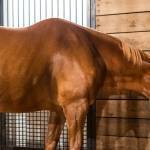Consider Haylage for Improved Respiratory Health in Horses

Although not commonly used in some areas of the world, haylage has several benefits that may tempt horse owners to try this convenient conserved forage. Two important advantages have been noted: (1) haylage generates less organic dust than traditional hay, making it desirable for horses at risk of asthma, and (2) haylage improves the omega-3 to omega-6 ratio of horse diets.
Asthma, even in its mildest form, limits a horse’s ability to perform. Inhaling dust, particularly the dust generated by hay, causes airway inflammation, thickens the walls of the airways, and triggers mucus accumulation. As a result, the flow of air slows, limiting the ability of oxygen molecules to diffuse across the lining of the lung tissues and to enter the bloodstream.
“Many performance horses, including racehorses, are fed traditional dry hay and spend the majority of their day stabled, both of which are known risk factors for equine asthma,” said Catherine Whitehouse, M.S., a nutrition advisor for Kentucky Equine Research.
To demonstrate that haylage is less detrimental than traditional hay for respiratory health, 43 horses were fed either dry hay, steamed hay, or haylage. Bronchoalveolar lavages (BAL or lung washes) were performed, respirable dust particles measured, and circulating omega-3 fatty acid levels assessed over a six-week period. Baseline BAL fluid (BALF) analysis showed that all horses had mild, naturally occurring airway inflammation at the start of the study.
The three main findings of this study included:
- The proportion of inflammatory cells called neutrophils in BALF was lower in horses fed haylage compared to horses fed dry hay. This improvement of the BALF was noted after only three weeks of feeding haylage and persisted for the duration of the study.
- Respirable dust exposure in the breathing zone of horses (the two-meter sphere surrounding the horse’s nose) was reduced by feeding haylage compared to dry hay.
- Horses fed haylage for six weeks had a higher ratio of anti-inflammatory to proinflammatory lipids (omega-3 to omega-6 ratio).
Airway mucus scores were also lower in the horses fed haylage compared to those fed dry hay by week 6 of the study.
“Haylage therefore generates less respirable dust than dry hay and decreases airway inflammation in horses with naturally occurring airway inflammation. These findings make haylage a desirable forage for improved respiratory health, especially in equine athletes predominantly housed in stalls,” Whitehouse said.
Additionally, the ratio of eicosapentaenoic acid (EPA, an anti-inflammatory omega-3 fatty acid) to arachidonic acid (AA, a pro-inflammatory omega-6 fatty acid) was improved after feeding haylage compared to dry hay or steamed hay.
“This difference was due to small increases in EPA and concurrent decreases in AA in horses fed haylage. While the ratio was significantly improved, the difference in individual variables did not reach statistical significance when compared individually across the different forages,” explained Whitehouse.
Omega-3 fatty acids are a recommended component of managing equine asthma according to the most recent consensus statement, contributing to the resolution of airway inflammation.
According to Whitehouse, “The long-chain polyunsaturated fatty acids EPA and DHA have anti-inflammatory properties, with EPA mitigating the inflammatory effects of AA. Fish oil is the best way to provide a direct source of both EPA and DHA in the diet to support a less inflammatory state. Kentucky Equine Research’s EO-3 is a potent, palatable marine-derived oil that is top-dressed onto feed.”
In this study, the horses accepted the haylage well. Although botulism can be a concern when feeding haylage that is either not fermented correctly or has a high moisture content, steps can be taken to maximize safety. For example, experts recommend properly storing haylage prior to feeding to prevent exposure to oxygen and spoilage, discarding any moldy product, and feeding haylage within three days of opening the bale. Further, horses may be vaccinated against Clostridium botulinum type B for additional protection.
*Olave, C.J., K.M. Ivester, L.L. Couetil, J. Burgess, J.H. Park, and A. Mukhopadhyay. 2023. Effects of low-dust forages on dust exposure, airway cytology, and plasma omega-3 concentrations in Thoroughbred racehorses: A randomized clinical trial. Journal of Veterinary Internal Medicine 37:338-348.








